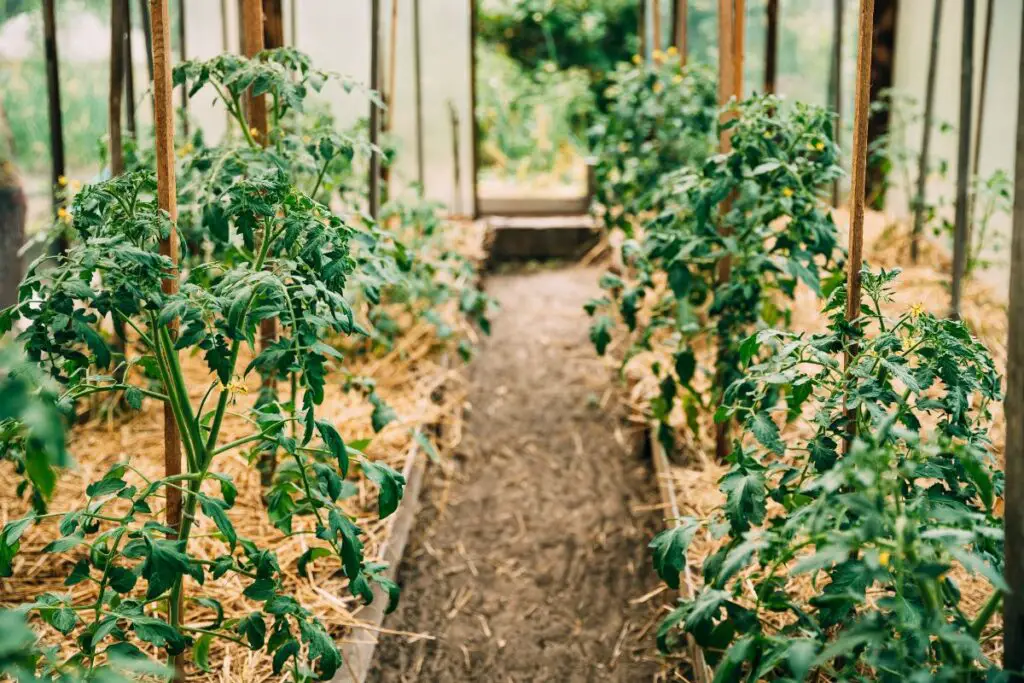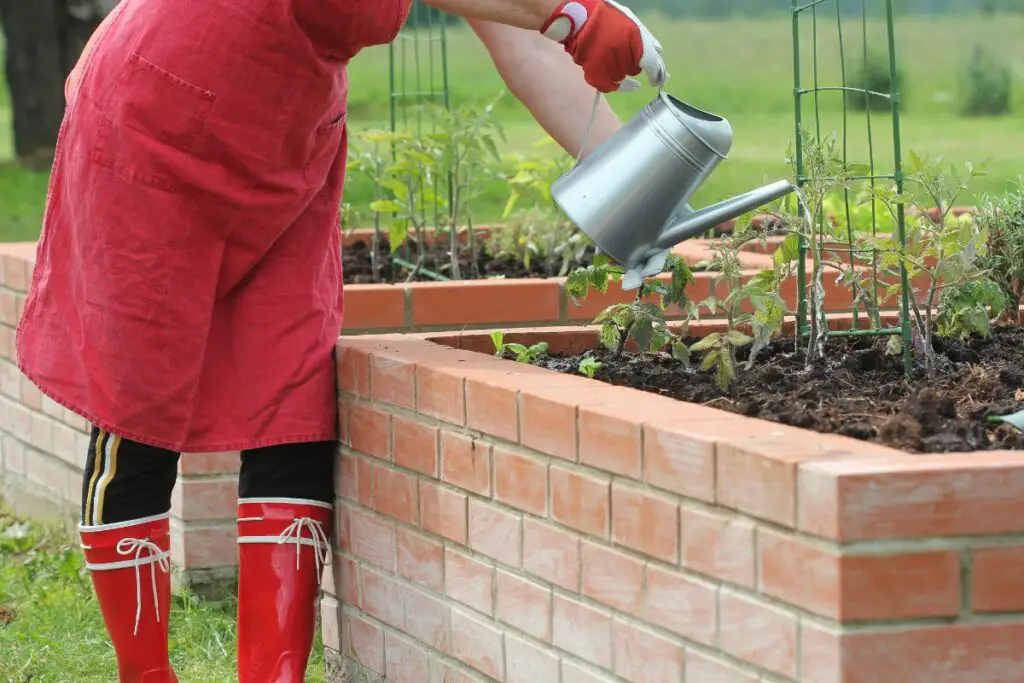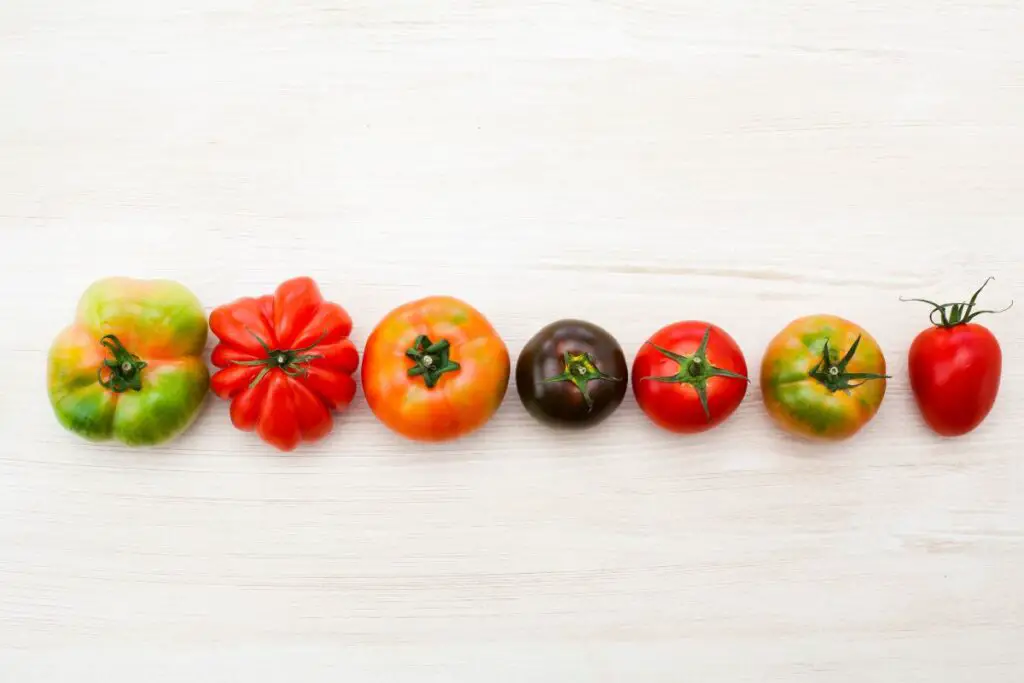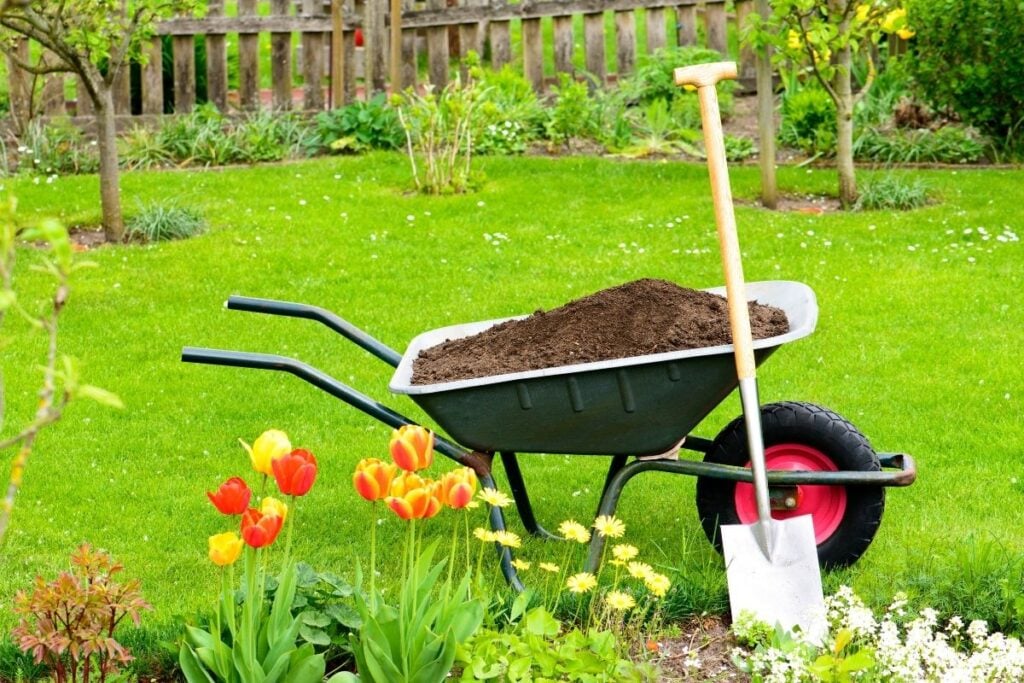A tomato plantation in a raised bed is a great idea and a straightforward process. Raised beds offer you more control over the soil and the nutrients you provide your plant. But before tomato plantation, it is important to know how far to space them in raised beds.
Generally, it is recommended to plant tomatoes 18-24 inches apart in a traditional garden. However, A raised bed is more compact, so each tomato plant can be grown 12-16 inches apart. The spacing will also differ with the variety of tomatoes you grow, as some larger varieties need more space.
The determinant tomato variety should be spaced 2 feet apart, whereas the indeterminate tomato variety should be spaced 18-24 inches for optimal growth.
This article will give you all the information about how far to space and plant tomatoes in a raised bed. So, read this article until the end if you plan to plant tomatoes in raised beds.

Why is spacing tomato plants important?
There are some important reasons why you should aim for well-spaced tomato plants.
If you don’t, you’ll notice the following issues.
- Stunted growth: Tomato plants need sufficient water, sunlight, and nutrients for growth. Without these resources, they will start competing with each other and have stunted growth.
- Low production: If tomato plants grow too closely, they may survive but will not produce enough tomatoes.
- Diseases: Tomato plants are susceptible to diseases, and if you grow them too closely, poor air circulation will increase the risk of diseases.
- Inadequate light: Tomato plants require plenty of sunlight to grow and thrive. If you crowd the seedling, the light will not reach every part of the plants as they grow.
Spacing tomato plants is helpful in several ways:
- Spacing will promote the healthy growth of tomato plants by providing them with proper light, water, and nutrients.
- Spacing will help the plants to perform proper pollination and maximize fruit production.
- Correct spacing will help the plants to get an ideal distribution of resources like proper airflow, water, sunlight, and nutrients.
- There is an ease in harvesting tomato plants.
How far apart to plant tomatoes in a raised bed?
A healthy plant will only grow if supported with the right amount of space.
Correct spacing becomes especially important if you grow tomato plants in raised beds.
Growing tomatoes in raised beds are beneficial since there will be fewer weeds, less digging, and soil issues.
You need to properly space the tomato plants in a raised bed and provide them with essential growing conditions.
Tomato plants are grown 2 feet apart in a normal or traditional garden.
In contrast, a raised bed garden is more compact, and the tomato plants can be grown more closely.
The ideal distance to raise tomato plants in the raised bed is at least 1 square foot apart or 18-24 inches apart.
This spacing will give the plants enough rooms to grow without getting crowded.
Spacing tomato plants closer to 24 inches will reduce air circulation and increase the chances of spreading disease.
You can also support your raised bed with a tomato cage or trellis.
This arrangement will help the plant to grow vertically.
If you want to plant many tomatoes in one raised bed, consider alternating the sides of your plant.
This change will prevent the growth of fungal diseases and other problems.
Supply your tomato-raised bed with rich soil to accommodate for closer planting.
How much space should be between tomato plants in raised beds?

When you want to grow tomatoes in a raised bed garden, spacing is one important factor you should keep in mind.
If you don’t want to grow tomato plants into each other, space them 2 inches apart.
But if you want them into each other, space them 1/2 inch apart.
However, you can move the plants anytime if you want to.
Spacing the tomatoes 2 inches apart is a great idea because, in this way, you will give the plant enough room for growth, and it will be easy to harvest them.
You can space the plant more if there are no weeds in your raised beds.
Another thing you need to decide is how many tomato plants you want to grow in your raised bed.
Measure out a square foot for each plant to calculate the number of plants you would like to grow in your raised bed.
To include other vegetables with tomatoes, you must divide the raised beds into smaller sections or parts.
For example, you may grow tomatoes in one section and carrots in the other.
How does tomato spacing differ by variety and type?

If you are growing tomatoes from seedlings, the spacing will depend on the type of tomato variety in the raised beds of your garden.
There are two main types of tomato varieties: determinant and indeterminate.
But before thinking of spacing, you need to decide whether you want to grow a determinant or indeterminate tomato variety.
Let us now study each variety in detail.
Looking for gardening supplies? We have tested 100's of products before recommending them to you guys. Check out our best pick below:
| Image | Gardening Supplies | Best Price? |
|---|---|---|
 Top
Top Top
Top | Raised Garden Bed Kit | Check On Amazon |
 | XLUX Soil Moisture Meter, Plant Water Monitor, Soil Hygrometer Sensor for Gardening, Farming, Indoor and Outdoor Plants, No Batteries Required | No Results |
 Top
Top Top
Top | 82 Pcs Garden Tools Set and Extra Succulent Tools Set | Check On Amazon |
 | Joeys Garden Expandable Garden Hose with 8 Function Hose Nozzle, Lightweight Anti-Kink Flexible Garden Hoses, Extra Strength Fabric with Double Latex Core, (50 FT, Black) | No Results |
 Top
Top Top
Top | Dual Chamber Compost Tumbler | Check On Amazon |
 Top
Top Top
Top | Sunnyglade Plant Stakes | Check On Amazon |
 Top
Top Top
Top | Organic Cold Pressed Neem Seed Oil | Check On Amazon |
 Top
Top Top
Top | Mighty Mint Gallon :-Insect and Pest Control Peppermint Oil | Check On Amazon |
 Top
Top Top
Top | Scotts DiseaseEx Lawn Fungicide | Check On Amazon |
 Top
Top Top
Top | Jacks Classic 20-20-20 All Purpose Fertilizer | Check On Amazon |
 Top
Top Top
Top | 30,000 Seeds Pollinator Attracting Wildflower Mixture | Check On Amazon |
 Top
Top Top
Top | Survival Vegetable Seeds Garden Kit-Over 16,000 Seeds | Check On Amazon |
Determinate tomato varieties
Determinate tomato varieties are compact plants and are small in size.
They produce tomatoes all at once relatively in a very short time.
The tomatoes tend to ripen very fast, so you may enjoy more than one harvest during one growing season.
They are bushy, have compact growth habit, and is quite common among commercial growers.
This tomato variety has a sweet and sour taste and is widely used for making sauces.
Some dwarf cherry hybrid plants fall under this category.
Spacing for determinate tomato varieties in raised beds
This variety of tomato plants has bushy growth but still requires small space between individual plants.
Mature full-sized determinate plants should be spaced 2-3 feet apart.
If many tomato plants grow in rows in raised beds, you need to space them 30 inches apart and leave 4 feet of space between rows.
If you are growing a dwarf variety, plant them close to 24 inches apart with 4 feet of space between rows.
If you are growing the plants from seedlings, space them further apart. You can leave 18-24 inches between each seed.
Indeterminate tomato varieties
Indeterminate tomato varieties are larger and grow up to 10 feet long.
This variety produces large fruits that can weigh 2 pounds and more.
Tomato varieties like heirloom and jelly bean cherry come under the indeterminate category.
The plant shows vigorous growth and continues to grow for an extended period.
They produce flowers and fruits until the fall season’s first frost destroys them.
This tomato variety requires plenty of space between individual plants since a single stem of this variety can branch into multiple stems will many tomatoes.
Spacing for indeterminate tomato varieties in raised beds
Indeterminate varieties require staking or support systems for growing tomatoes, except for cherry varieties that grow in containers.
This tomato variety tends to grow in a vining manner, so they need extra space for growing.
Space the tomato plants 18 -24 inches apart to allow proper air circulation and light penetration.
The distance between rows should be at least 3 feet.
Also, the plants will require timely pruning to support production and increase airflow through the vines.
Mistakes to avoid while growing tomato plants in raised beds
Tomatoes are not hard to grow, but they can be fussy sometimes, and if you aren’t careful, several problems can come your way.
1. Lack of proper planning
Before preparing the raised beds, you must decide how many tomato plants you want to grow and how many you want to use.
It would help if you planned whether you want to eat raw tomatoes, slice them into salads, can them, or make salsa.
Considering these things is important for deciding your tomato pants’ harvesting time.
You can follow seed catalogs for more information.
2. Poor selection of site
Tomato prefers to grow in well-drained soil and needs 7-8 hours of direct sunlight daily.
The tomato plants will suffer if they don’t get either of them.
To reduce the possibility of diseases, avoid planting your tomatoes where vegetables like potatoes or pepper have grown within the last 2 years.
3. Using incorrect soil
Tomatoes in a raised bed will have a different soil requirement than the garden ones.
Raised beds are not soil but materials like gravel, bricks, wood planks, stone, plastics, etc.
Therefore, you need to amend the raised bed with manure or compost to make it suitable for tomato plantation.
Take a generous amount of compost, rotten manure, and organic materials like leaf mulch.
Dig the soil to a depth of 8-10 inches for planting your tomato seedlings.
Also read: How Much Soil Do I Need For A Raised Bed? (+Soil Bags Estimates)
4. Overcrowding
Tomato plants need plenty of space to grow, so make sure you don’t overcrowd them by planting too many plants in a very small place.
Figure out optimum spacing by analyzing the tomato variety you want to grow.
5. Improper feeding

Tomato plants are moderate feeders, and over-fertilization can promote lush growth at the expense of fruits.
You should fertilize the tomato plant when the fruit is about an inch (2.5cm) in diameter and again when the harvesting season begins.
Consider using an organic fertilizer with an NPK ratio of 3-4-6 or 4-7-10 for your tomato plants.
6. Planting in the wrong season
The tomato plant is a warm-weather crop; you shouldn’t plant the seedling until the weather becomes warm and the danger of frosts has passed.
If there is any unexpected frost, cover the plants with hot caps.
7. Improper watering
Tomato plants will never grow well if you do shallow watering.
Instead, water the plants until the ground is soaked to a depth of 8-10 inches, and let the soil dry out before the next watering.
If the soil has more sand content, provide the plant with a good soaking every 4-5 days, and if the soil has a heavy texture, water the plant every 7-9 days.
To prevent diseases, water the tomatoes early in the day.
Also read: How To Water A Raised Garden Bed? (+8 Mistakes To Avoid)
8. Not paying enough attention
Keep eyeing your tomato plants for early signs of pests and diseases.
Also, keep the weeds in check when they are small, as the large weeds will complete your tomato plants for moisture and nutrients.
How to care for tomato plants in a raised bed?
Tomato plants need maximum care and attention when they are young.
During this time, there are high chances for them to get spoiled.
Follow the care tips below to get a mature and fruiting tomato plant.
| Factor | Care requirements |
|---|---|
| Watering | Keep the soil evenly moist. Raised beds quickly dry out compared to the garden, so the plant will need frequent watering. Water the plants daily and keep the soil damp up to six inches below the surface. Always water the tomato plants slowly and deeply to build a strong root system. |
| Fertilization | Fertilize your tomato plant with a well-balanced organic fertilizer or compost tea by watering once or twice a week. Fertilizers will make the plant more strong and healthy. |
| Soil | Tomato plants are heavy feeders and prefer a rich organic soil mix. Take any light topsoil or raised bed soil and mix 2-3 inches layers of compost or cow manure to 1/3 of the soil. |
| Temperatures and humidity | The ideal temperatures for tomatoes are between 70 and 85°F. Relative humidity of 65-85% will be optimum for tomato plant development. |
| Pruning | Indeterminate tomato varieties require frequent pruning as they grow long branches that develop flowers and fruits in all branches. You can prune some of these branches so that the plant can focus entirely on fruits and flowers. |
Reference: ScienceDirect, American Society of Agronomy, Noble Research Institute, Soil for Raised Beds, Raised Bed Gardening, Tomatoes in the Garden.
